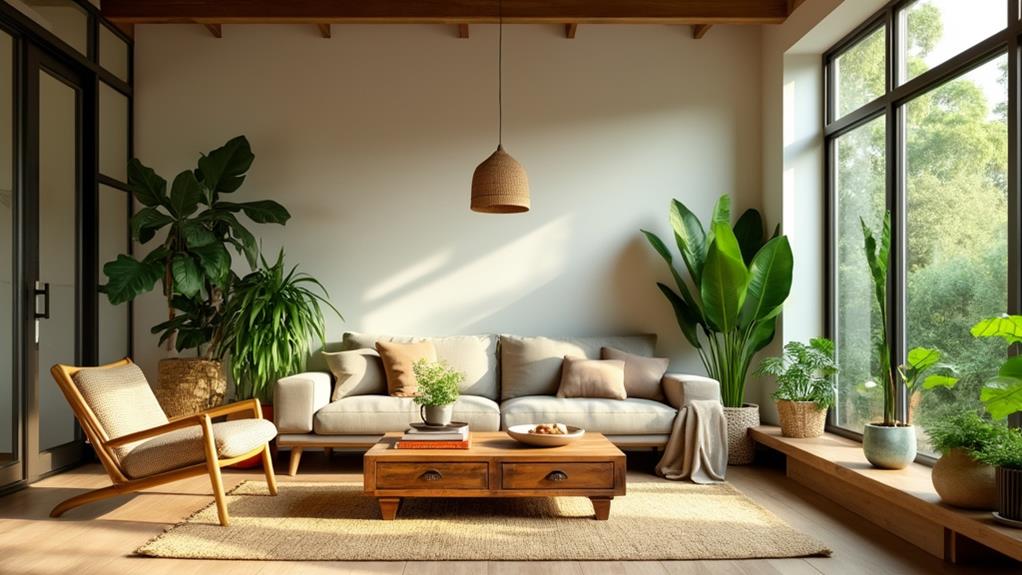Sustainable furniture trends are transforming living spaces through the integration of organic designs, multifunctional minimalism, and smart technology. Focusing on earthy aesthetics, these trends use natural materials like wood and stone, blending retro elements for a nostalgic yet modern appeal. Ergonomic seating solutions enhance comfort, while customizable furniture offers adaptability to personal needs. Eco-friendly practices prioritize the use of reclaimed woods and recyclable materials, promoting environmental responsibility. Statement pieces serve both functional and aesthetic roles, while smart tech integration provides advanced conveniences. Emphasizing wellness and functionality, these trends redefine home environments, offering more insights into this evolving industry.
Table of Contents
ToggleOrganic and Earthy Designs
Frequently, interior design trends evolve to reflect a deeper connection with nature, as seen in the growing preference for organic and earthy designs in furniture.
This shift emphasizes organic forms and softer styles, utilizing natural materials such as wood, stone, and leather. These elements not only enhance a space's aesthetic appeal but also foster a serene and calming environment.
The color palette typically includes earthy tones, ranging from rich dark chocolate browns to soft beiges, which offer versatility for decor changes.
Additionally, the fusion of retro design elements with contemporary touches adds emotional depth and nostalgia to interior spaces. Such designs resonate with individuals seeking to create harmonious living environments that reflect a balance between modernity and nature.
Ergonomic Seating Solutions
Emphasizing comfort and functionality in modern living, ergonomic seating solutions are becoming increasingly vital in furniture design. These solutions prioritize health and well-being, integrating features that support ideal body alignment and reduce strain during prolonged use.
A key focus is on adaptability, allowing furniture to cater to diverse user preferences.
- Adjustability: Ergonomic chairs often feature adjustable elements, such as height and armrests, to accommodate various body types and work environments.
- Supportive Design: Lumbar support is essential, helping to maintain the natural curve of the spine and prevent back pain.
- Material Innovation: Utilizing breathable, durable materials enhances comfort and longevity, ensuring that seating solutions remain both functional and sustainable.
These trends highlight the growing intersection of design innovation and user-centric functionality.
Multifunctional Minimalism
Building upon the principles of ergonomic seating solutions, the concept of multifunctional minimalism in furniture design gains prominence as modern living spaces demand more adaptable and efficient solutions.
This trend emphasizes simplicity and utility, with designs that maximize functionality while maintaining aesthetic appeal. Multifunctional pieces, such as sofa beds and extendable tables, offer practical solutions for space constraints, allowing for seamless shifts between different room uses.
By integrating versatile elements, these designs cater to dynamic lifestyles, optimizing spatial efficiency. The balance between form and utility is essential, as minimalist designs focus on reducing clutter and enhancing functionality.
This approach not only meets practical needs but also aligns with the growing desire for streamlined, elegant living environments that prioritize both form and function.
Customizable Furniture Options
Customizable furniture options are revolutionizing the way individuals interact with their living spaces, offering a unique blend of personalization and functionality. This trend allows consumers to tailor furniture pieces to their specific needs, enhancing both aesthetic appeal and practical utility.
By integrating bespoke designs, individuals can reflect personal style while addressing functional requirements. This customization trend manifests in several ways:
- Modular Designs: Furniture that can be reconfigured offers flexibility, adapting to changing spatial needs.
- Material Selection: Consumers can choose from a variety of finishes and fabrics, ensuring the furniture aligns with their decor.
- Technological Integration: Incorporating smart features into furniture allows for enhanced user interaction, meeting modern lifestyle demands.
This shift towards customization underscores a growing demand for personalized living environments.
Eco-Friendly Material Choices
Sustainable practices are reshaping the furniture industry as eco-friendly material choices gain prominence. Increasingly, consumers are demanding products that prioritize environmental impact.
Consequently, manufacturers are turning to materials such as reclaimed wood, bamboo, and recycled metals, which offer both durability and reduced ecological footprints. Innovations in biodegradable materials, including plant-based composites, reflect a growing commitment to sustainability.
Additionally, the industry is witnessing a shift towards transparency, with companies providing detailed information about the origins of their materials. This transparency enhances consumer trust and engagement, encouraging responsible purchasing decisions.
As these eco-friendly materials gain traction, they not only contribute to reducing environmental harm but also align with the broader movement towards sustainable living, making them a cornerstone of modern furniture design.
Textural Diversity
The furniture industry's commitment to eco-friendly material choices naturally extends to an exploration of textural diversity, which offers both tactile and visual enhancement to living spaces.
Textural diversity in sustainable furniture design emphasizes the integration of varied materials to create engaging and dynamic environments. This approach not only enhances aesthetic appeal but also improves durability and comfort.
Manufacturers are increasingly experimenting with innovative textures to meet consumer demand for unique and sustainable options. Key elements include:
- Material Blending: Combining soft fabrics with robust woods or metals for a balanced sensory experience.
- Layering Techniques: Using multiple textures in a single piece to add depth and complexity.
- Durability and Longevity: Selecting textures designed to withstand frequent use, ensuring long-lasting quality and environmental sustainability.
Statement Pieces
Bold furniture pieces are becoming increasingly central to modern interior design, serving both functional and aesthetic purposes.
These statement pieces, such as creatively designed bookshelves and vibrant sofas, allow for self-expression and add a unique dimension to living spaces. Utilizing durable materials with rich colors and diverse textures, they combine timeless design elements with modern elegance, ensuring both beauty and practicality.
The importance of selecting pieces that withstand daily use while retaining their visual appeal cannot be overstated. By harmoniously blending functionality with striking aesthetics, statement furniture provides a focal point in any room.
Their ability to transform an interior environment highlights their significance in current sustainable furniture trends, emphasizing both longevity and style in home décor.
Smart Technology Integration
Increasingly, furniture design is embracing smart technology integration to enhance functionality and user experience.
With advancements in technology, furniture pieces are now equipped with features that cater to modern lifestyle needs. These innovations aim to provide convenience and efficiency within living spaces.
Here are three key aspects of smart technology integration in furniture:
- Embedded Charging Stations: Furniture now includes built-in USB ports and wireless charging pads, eliminating the need for unsightly cables and offering seamless device charging.
- Adjustable Features: Smart furniture often includes motorized components, allowing users to customize seating positions or desk heights at the touch of a button, improving ergonomic comfort.
- Connectivity: Integration with smart home systems enables furniture to interact with other devices, providing users with centralized control over lighting, sound, and more.
Wellness-Focused Design
As technology continues to redefine our living spaces with smart integrations, furniture design is also increasingly aligning with the principles of wellness-focused design.
This trend emphasizes creating environments that promote relaxation, mental health, and overall well-being. Key elements include ergonomic furniture, which supports ideal posture and reduces physical strain, and natural materials, which enhance the connection to nature and provide a calming influence.
Additionally, spaces are being designed to encourage mindfulness, incorporating features that facilitate tranquility and stress reduction. The integration of biophilic design elements, such as indoor plants and natural lighting, further supports mental health by mimicking outdoor environments.
As consumer awareness of health and wellness grows, furniture that enhances these aspects is becoming a priority in sustainable design.
Antique and Modern Fusion
Combining antique and modern furniture has emerged as a compelling trend in interior design, creating visually harmonious spaces that artfully bridge the past and present.
This trend not only adds character to living spaces but also allows for personalization and unique style expression. By skillfully merging vintage pieces with contemporary designs, homeowners can craft interiors that are both timeless and current.
Here are three key strategies to achieve this fusion:
- Balance and Contrast: Pair antiques with modern pieces featuring soft curves to create a cohesive look.
- Material Harmony: Select high-quality fabrics that complement vintage aesthetics without overpowering them.
- Focal Points: Strategically place antiques to create focal points within contemporary settings, enhancing the room's overall allure.
This fusion results in spaces that are both functional and visually appealing.


